Incomes, Ages, Backgrounds: The Changing Profile of Apartment Renters in the Vancouver Region
By Vaishali, Senior Analyst, Research Services & Strategy and Wendy Waters, Vice President,
Research Services & Strategy, GWL Realty Advisors[1]
A substantial portion of Vancouver’s population is choosing to rent rather than aspiring to own a home. This trend has been evolving for several decades, enhanced by urban living becoming fashionable for many, whether as a condo owner or apartment renter. As GWLRA has outlined in previous publications going back to 2011, as many as half of renters had the income to afford ownership in the region, but preferred to rent, often to achieve a more cosmopolitan lifestyle. This trend has continued and spread nationally. In the 2023 Canadian Multi-residential satisfaction survey of 20,000 renters,[2] 46% prefer renting as a lifestyle choice and 67% are planning a future in rental.
Using estimates from the 2021 Census[3] for the Vancouver CMA (Census Metropolitan Area), GWLRA Research analyzed these middle- and higher-income renters to understand recent shifts in rental household characteristics that can impact apartment building management. For landlords as well as rental developers, understanding the backgrounds, motivations and circumstances of renters is helpful in marketing as well as providing the right services or amenities and even budgeting maintenance.
The 2021 Census reveals the extent of renting in the Vancouver area; in fact, 38% (Figure: 1a) of households in Vancouver CMA region are renters. This figure rises to 52% (Figure: 1b) among the apartment/condo dwellers. Other major Canadian cities also have substantially larger proportion of renters (Figure:1).
Lack of down payment as well as high mortgage payments due to rising interest rates and inflation are some of the reasons why renting is becoming an even more common way of life. In addition, many renters like the added services of a rental building and prefer flexibility over long-term financial commitment[1].
Figure:1 a, b Distribution of owners and renters in all dwelling structures vs. all apartments (apartments and condos)
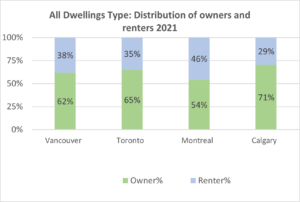
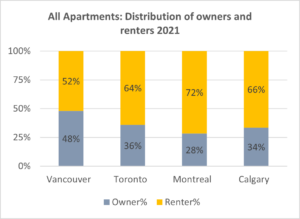
Who are the renters?
In terms of tenant age distribution, 50%[4] of renters in Metro Vancouver are between the ages of 25 and 44, up from 45% in 2016[3]. The household structure of tenants is such that one person living alone is the highest share followed by one family without children (i.e. a couple), and one family with children. Immigrants account for 40% of renters, while visible minorities account for 44%[5]. However, the share of immigrants and visible minorities for the overall population is higher at 48% and 49% respectively, indicating slight under-representation of this group in the renter population.
A common misconception is that renters are households with lesser incomes. On the contrary, 37% of the renters in 2021 had an income of $100,000 or more, and 64% of the renters had an annual household income of $70,000 or more (Figure: 2a). The share of renters with household incomes of over $100k rose sharply, by 11%, between 2016 and 2021 (Figure: 2 a,b), while the share of renters with lower incomes decreased. The average household income of renters before taxes in 2021 was $77,000, a 37%[6] increase from 2016 ($56,395). Even after accounting for 10.3%[7] CPI inflation during this five-year period, we see a significant increase in average income. Additionally, since 2011, the median income of economic immigrants (after adjusting for inflation) has also increased, growing by 20%[8] between 2016-2020.
With more households in higher income brackets renting and renter incomes increasing in 2021, we can infer that these renters can and are able to afford increased rental rates. Furthermore, they can also be the potential tenants for newer rental product which typically garners higher rents.
Figure:2 a,b Distribution of apartment (apartments and condos) renters by income in 2021 vs. 2016
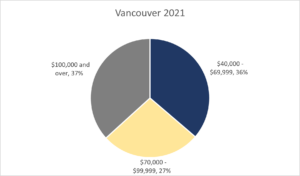
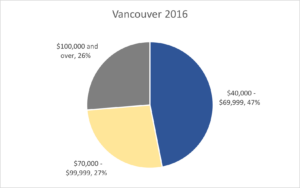
Who rents the new vs. old stock:
Renters have limited choice when it comes to the age of their rental home. More than 80%[9] of all purpose-built rental stock is pre-2000s built, and 70%5 was built prior to the 1980s. As a result, the vast majority of tenants are confined to the ageing housing stock. 67% of renters live in housing older than 2000 (Figure: 3). Interestingly, 12% (Figure: 3) of renters reside in newly built (2016-21) apartment and condos, which is indicative of the surge in new supply in the Vancouver market in the recent years.
Figure: 3 Distribution of renters by vintage of apartment (apartments and condos) product
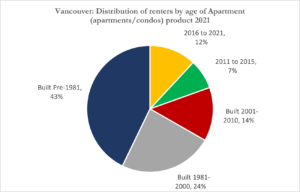
A significant portion of the newer product is rented by younger tenants. Often this is because newly constructed stock is the only option available when new tenant households are looking for a rental home. This can also be inferred from the low turnover rates in Vancouver in the last several years, which further dropped to 10.7%[10] in 2022.
As per 2021 census estimates, 70% of the renters in the newly built apartments (constructed during 2016-2021) belong to the 25–44- age group. The income classification of renters in newer product suggests that renter households earning $100,000 or higher constitute the largest share. 67% of renters in newer product (apartments built between 2016-2021) had an annual household income of $70,000 or more (Figure: 4a). This share was substantially lower for the pre 1981 stock at 60% (Figure: 4b).
Figure: 4 a,b Distribution of renters in new vs. old product by income
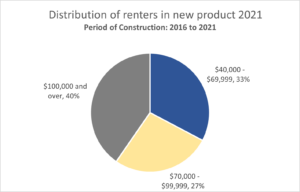
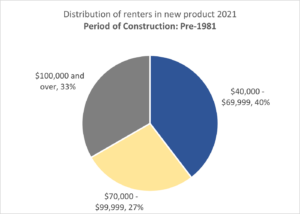
Source: Census 2021
In terms of household structure, 43% of tenants in newer product come from one-person households, however this is down from 2016. (46% in 2016 to 43% in 2021). The share of two or more person households in new product has increased (10% in 2016 to 13% in 2021). This shift is likely owing to rising rents as a result of an acute housing shortage. It takes two incomes for many to afford a new one-bedroom unit. For rental operators, this trend toward more adults in one-bedroom units could have implications for wear and tear costs of the buildings.
It’s also worth noting that the share of renters who are immigrants, non-permanent residents or members of visible minorities increases in newer product. While immigrants and non-permanent residents accounted for only 36% and 6% of renters in the older product respectively, their share increased to 39% and 21% respectively in the new product (Figure: 5a). Similarly, the share of visible minority renters is also significantly higher in newer product at 57% compared to 32% in the older product (Figure: 5b). It’s worth considering that new Canadians (often visible minorities) have no other option than to rent the new product that is typically more expensive because there is no vacancy in older units that are usually at lower rents.
Figure: 5 (a,b) Number of apartments and condos renters by period of construction and Immigrant and visible minority status

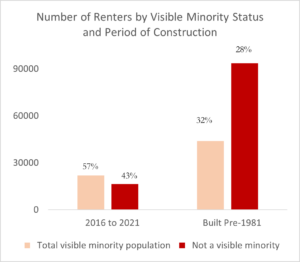
Is there enough supply to support renting as a lifestyle choice?
The rising number of apartment renters combined with near stagnant supply is aggravating the longstanding demand-supply imbalance in rental housing. While the number of renters in Vancouver climbed by 42% between 2016 and 2021, the number of purpose-built rental units recorded only a minimal growth of 6% (Figure: 6). (This leaves condominiums, secondary suites, and overcrowding as the rental solutions for many renters.) The growth of younger renter households (i.e., 25–34-year-olds) is even more significant—an 80% increase for the five-year period. This massive demand-supply gap has resulted in skyrocketing rents for vacant apartment units.
Figure: 6 Renters vs the rental stock for Vancouver CMA region
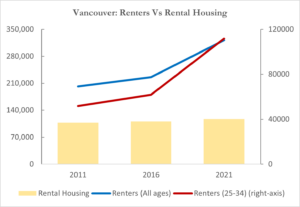
Conclusion:
For decades in Vancouver, renters have increasingly included people choosing an urban, rental lifestyle over the trade-offs and responsibilities of home ownership (whether condominium or ground-oriented homes). In the current environment of high interest rates, inflation and economic uncertainties even more individuals will likely rent, whether forever or for longer. As our analysis in this piece shows, an increasing share of renters are young adults with solid incomes, and many are immigrants. This said, the market also contains renters with modest and low incomes, even if this share is declining. The new census data helps to remind us that there are a wide variety of renters in the Vancouver Metro Area.
* This article was originally published in the winter 2023 edition of The Key magazine.
Footnotes for this post can be read here.
Recommended reading:
A tale of two renters: Housing affordability among recent and existing renters in Canada, 2023
Research Notes and Whitepapers @ www.gwlrealtyadvisors.com/research
Immigration – A Positive Tailwind for Multi-Family Demand in Canada, 2022
Myth Busting: Renters’ Ownership Capacity in Toronto, Edmonton and Vancouver, 2011
